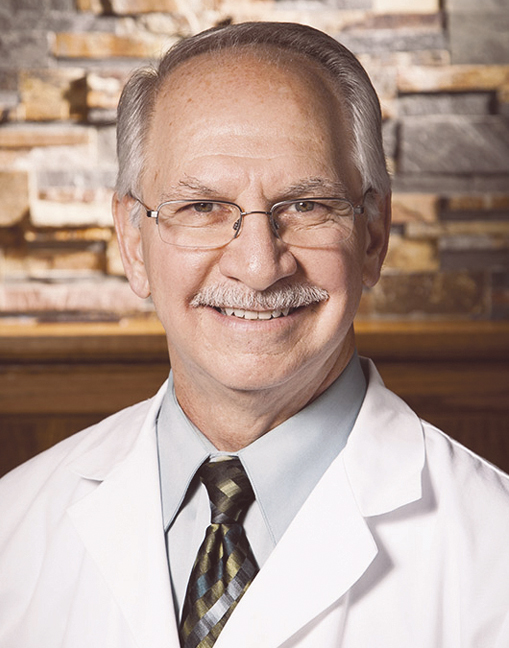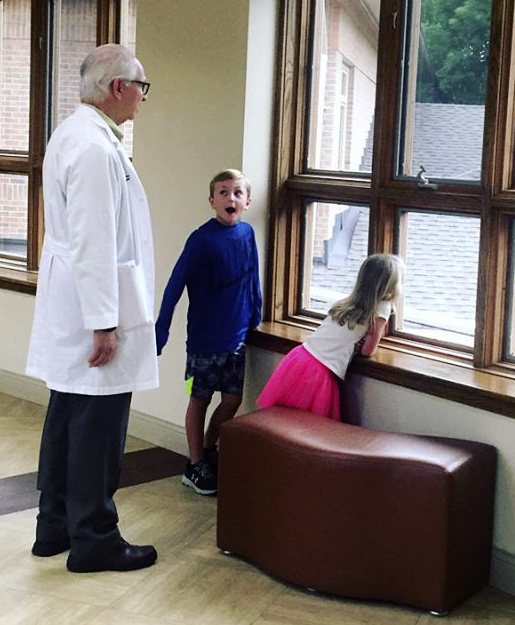At 70, Hospice Senior Medical Director Dr. Jules Sherman retires

‘I do what I can, with my heart’
By Marshall Weiss, The Dayton Jewish Observer
It was 1979 when oncologist Dr. Jules Sherman first connected with Hospice of Dayton.
“Within a year of starting my practice, I met Betty Schmoll, who was the nurse that started Hospice of Dayton,” Sherman, a Philadelphia native, says. Schmoll established the hospice in 1978 with six homecare nurses.
“I was a new cancer specialist in town, and then she heard I had a lot of training in my fellowship in pain management,” he says, “so she asked if I would lecture those nurses in pain management.”
When St. Elizabeth’s Hospital donated 13 beds for Hospice’s inpatient unit in 1984, Sherman and another oncologist became voluntary medical directors to care for those patients.
This September — after nearly 40 years of advancing palliative care in the Miami Valley — Sherman retired as medical director of Ohio’s Hospice of Dayton, a full-time position he held since 2002.
Sherman was one of the first physicians to receive certification in palliative medicine from the American Academy of Hospice and Palliative Medicine, which was established in 1988.
Until then, the emerging specialty of hospice care had been a subspecialty of oncology and cardiology.
It was the new certification, Sherman says, that drew physicians from other specialties to this work, which he describes as a calling.
“When Hospice started, 95 percent of them were cancer patients,” he says. “Now, it’s about maybe 40 percent are cancer patients.”
Sherman says Ohio’s Hospice of Dayton now cares for 900 patients, mostly in homecare and extended-care facilities such as nursing homes. Satellites in the Ohio’s Hospice system serve another 600 patients.
Sherman also oversaw the care for Hospice’s 52-bed inpatient unit on Wilmington Avenue in Dayton, for those who require more intensive care; he was on the committee that selected the campus site.
He says the “100-percent” focus for him and his medical team has been patients’ physical and emotional comfort.
“What we do a lot is helping families get through it,” he adds. “Sometimes families are more at strife than the patient themselves.”
Hospice staff also help each other through the emotional challenges they face.
“We have support groups for staff all the time,” Sherman says. “We have wonderful social workers that are really adept at providing that support. And as the physicians, we all support one another.
“I am used to seeing people die, because you do it so much. It’s emotional, but I have to be able to go see the patient in the next room no matter what’s happening, so you have to be able to pull it in. I raised a family — I didn’t want to bring that type of distress home to them.”
Sherman, 70, describes himself as a practicing Jew and an agnostic; he says his years in palliative care have led him to question his faith.
“I wish I didn’t, but I’m always searching for my belief in God,” he says. “But in what I did in my life as a doctor, I didn’t see God intervening. Other people will say, ‘Well you should,’ but I see the young and old suffering, and I do what I can, with my heart, to get them comfortable.”
He says he has drawn on Judaism’s ethical commandments in his work.
“Every individual I treat has a story,” he says. “And every one of those individuals, I have to mold what I learned to fit not only their physical ailment but their emotional ailments over this.”
Before the hospice care movement arrived, Sherman notes that most people died in hospitals.
“Now, a lot of people can die at home, peacefully, in a nursing home, peacefully, and the ones that are on the edge of needing more extreme care can come into the inpatient unit and their families know from the beginning that we’re going to hold their hand, and the patient’s, from the time they sign on to Hospice until well after the funeral and bereavement, into the future with families.”
Even so, he says that families sometimes prevent patients from dying at peace.
“At a time of life when peace should be there in the discussion, there could be a lot of strife,” he says.
“I’ll give you an example. A patient comes in dying of cancer, in extreme pain. We have drugs that can deal with that. This doesn’t happen all the time. But I can give these drugs, control the pain, go in the next day and the family’s pushing back: ‘Dad’s sleeping all the time. Now he’s too groggy, he can’t interact with us.’ And they’re to a point where we’re talking about days or weeks of survival. And when I do lighten the drugs, he’s more alert, but he’s in agony again.”
Hospice staff, Sherman says, are trained to be counselors, to negotiate the needs of the patient with those of the family.
“A lot of times people were divorced and they have children from a first marriage, so you have the new wife of 10 years but the kids from the previous marriage. They come into the picture and they want opposite things.”

Over the last three years, Sherman has lightened his load with an eye on retirement.
“I have five grandkids, here and in Mason,” he says. “Ava and I will travel.”
He loves fly fishing and has taught his older grandchildren to fly fish.
“There comes a time. This does become harder and harder to do. When I make rounds now in the inpatient unit, half the people are younger than me. We have patients in the unit all of the time down in their 20s. Those are hard things to deal with.
“Any of us who have worked at Hospice 10, 20 years have seen an awful lot of ways death can go: from a pleasant, comfortable experience to an extreme distress. I hired a lot of the doctors at the beginning and I think maybe everyone but one or two are still at Hospice. I’m very proud of that.”
To read the complete October 2018 Dayton Jewish Observer, click here.

